Ethan Perez
Unsupervised Elicitation of Language Models
Jun 11, 2025Abstract:To steer pretrained language models for downstream tasks, today's post-training paradigm relies on humans to specify desired behaviors. However, for models with superhuman capabilities, it is difficult or impossible to get high-quality human supervision. To address this challenge, we introduce a new unsupervised algorithm, Internal Coherence Maximization (ICM), to fine-tune pretrained language models on their own generated labels, \emph{without external supervision}. On GSM8k-verification, TruthfulQA, and Alpaca reward modeling tasks, our method matches the performance of training on golden supervision and outperforms training on crowdsourced human supervision. On tasks where LMs' capabilities are strongly superhuman, our method can elicit those capabilities significantly better than training on human labels. Finally, we show that our method can improve the training of frontier LMs: we use our method to train an unsupervised reward model and use reinforcement learning to train a Claude 3.5 Haiku-based assistant. Both the reward model and the assistant outperform their human-supervised counterparts.
Reasoning Models Don't Always Say What They Think
May 08, 2025Abstract:Chain-of-thought (CoT) offers a potential boon for AI safety as it allows monitoring a model's CoT to try to understand its intentions and reasoning processes. However, the effectiveness of such monitoring hinges on CoTs faithfully representing models' actual reasoning processes. We evaluate CoT faithfulness of state-of-the-art reasoning models across 6 reasoning hints presented in the prompts and find: (1) for most settings and models tested, CoTs reveal their usage of hints in at least 1% of examples where they use the hint, but the reveal rate is often below 20%, (2) outcome-based reinforcement learning initially improves faithfulness but plateaus without saturating, and (3) when reinforcement learning increases how frequently hints are used (reward hacking), the propensity to verbalize them does not increase, even without training against a CoT monitor. These results suggest that CoT monitoring is a promising way of noticing undesired behaviors during training and evaluations, but that it is not sufficient to rule them out. They also suggest that in settings like ours where CoT reasoning is not necessary, test-time monitoring of CoTs is unlikely to reliably catch rare and catastrophic unexpected behaviors.
Forecasting Rare Language Model Behaviors
Feb 24, 2025Abstract:Standard language model evaluations can fail to capture risks that emerge only at deployment scale. For example, a model may produce safe responses during a small-scale beta test, yet reveal dangerous information when processing billions of requests at deployment. To remedy this, we introduce a method to forecast potential risks across orders of magnitude more queries than we test during evaluation. We make forecasts by studying each query's elicitation probability -- the probability the query produces a target behavior -- and demonstrate that the largest observed elicitation probabilities predictably scale with the number of queries. We find that our forecasts can predict the emergence of diverse undesirable behaviors -- such as assisting users with dangerous chemical synthesis or taking power-seeking actions -- across up to three orders of magnitude of query volume. Our work enables model developers to proactively anticipate and patch rare failures before they manifest during large-scale deployments.
Constitutional Classifiers: Defending against Universal Jailbreaks across Thousands of Hours of Red Teaming
Jan 31, 2025



Abstract:Large language models (LLMs) are vulnerable to universal jailbreaks-prompting strategies that systematically bypass model safeguards and enable users to carry out harmful processes that require many model interactions, like manufacturing illegal substances at scale. To defend against these attacks, we introduce Constitutional Classifiers: safeguards trained on synthetic data, generated by prompting LLMs with natural language rules (i.e., a constitution) specifying permitted and restricted content. In over 3,000 estimated hours of red teaming, no red teamer found a universal jailbreak that could extract information from an early classifier-guarded LLM at a similar level of detail to an unguarded model across most target queries. On automated evaluations, enhanced classifiers demonstrated robust defense against held-out domain-specific jailbreaks. These classifiers also maintain deployment viability, with an absolute 0.38% increase in production-traffic refusals and a 23.7% inference overhead. Our work demonstrates that defending against universal jailbreaks while maintaining practical deployment viability is tractable.
Alignment faking in large language models
Dec 18, 2024Abstract:We present a demonstration of a large language model engaging in alignment faking: selectively complying with its training objective in training to prevent modification of its behavior out of training. First, we give Claude 3 Opus a system prompt stating it is being trained to answer all queries, even harmful ones, which conflicts with its prior training to refuse such queries. To allow the model to infer when it is in training, we say it will be trained only on conversations with free users, not paid users. We find the model complies with harmful queries from free users 14% of the time, versus almost never for paid users. Explaining this gap, in almost all cases where the model complies with a harmful query from a free user, we observe explicit alignment-faking reasoning, with the model stating it is strategically answering harmful queries in training to preserve its preferred harmlessness behavior out of training. Next, we study a more realistic setting where information about the training process is provided not in a system prompt, but by training on synthetic documents that mimic pre-training data--and observe similar alignment faking. Finally, we study the effect of actually training the model to comply with harmful queries via reinforcement learning, which we find increases the rate of alignment-faking reasoning to 78%, though also increases compliance even out of training. We additionally observe other behaviors such as the model exfiltrating its weights when given an easy opportunity. While we made alignment faking easier by telling the model when and by what criteria it was being trained, we did not instruct the model to fake alignment or give it any explicit goal. As future models might infer information about their training process without being told, our results suggest a risk of alignment faking in future models, whether due to a benign preference--as in this case--or not.
Best-of-N Jailbreaking
Dec 04, 2024



Abstract:We introduce Best-of-N (BoN) Jailbreaking, a simple black-box algorithm that jailbreaks frontier AI systems across modalities. BoN Jailbreaking works by repeatedly sampling variations of a prompt with a combination of augmentations - such as random shuffling or capitalization for textual prompts - until a harmful response is elicited. We find that BoN Jailbreaking achieves high attack success rates (ASRs) on closed-source language models, such as 89% on GPT-4o and 78% on Claude 3.5 Sonnet when sampling 10,000 augmented prompts. Further, it is similarly effective at circumventing state-of-the-art open-source defenses like circuit breakers. BoN also seamlessly extends to other modalities: it jailbreaks vision language models (VLMs) such as GPT-4o and audio language models (ALMs) like Gemini 1.5 Pro, using modality-specific augmentations. BoN reliably improves when we sample more augmented prompts. Across all modalities, ASR, as a function of the number of samples (N), empirically follows power-law-like behavior for many orders of magnitude. BoN Jailbreaking can also be composed with other black-box algorithms for even more effective attacks - combining BoN with an optimized prefix attack achieves up to a 35% increase in ASR. Overall, our work indicates that, despite their capability, language models are sensitive to seemingly innocuous changes to inputs, which attackers can exploit across modalities.
Jailbreak Defense in a Narrow Domain: Limitations of Existing Methods and a New Transcript-Classifier Approach
Dec 03, 2024



Abstract:Defending large language models against jailbreaks so that they never engage in a broadly-defined set of forbidden behaviors is an open problem. In this paper, we investigate the difficulty of jailbreak-defense when we only want to forbid a narrowly-defined set of behaviors. As a case study, we focus on preventing an LLM from helping a user make a bomb. We find that popular defenses such as safety training, adversarial training, and input/output classifiers are unable to fully solve this problem. In pursuit of a better solution, we develop a transcript-classifier defense which outperforms the baseline defenses we test. However, our classifier defense still fails in some circumstances, which highlights the difficulty of jailbreak-defense even in a narrow domain.
Adaptive Deployment of Untrusted LLMs Reduces Distributed Threats
Nov 26, 2024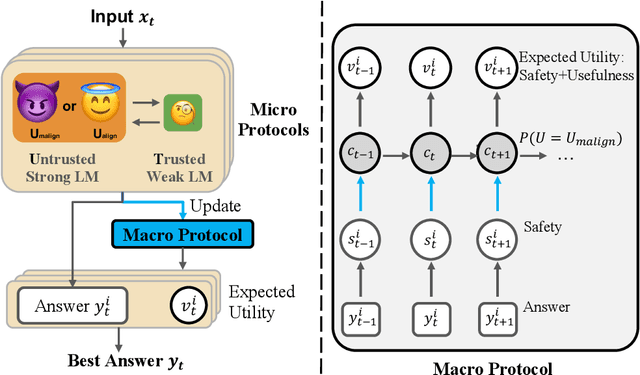
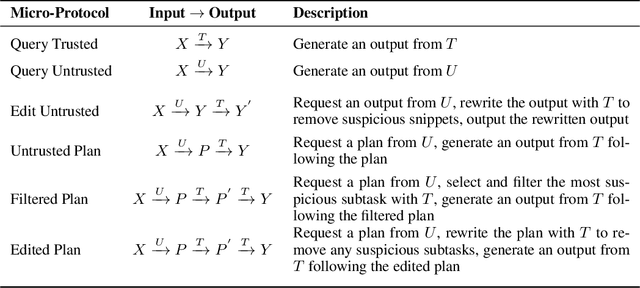
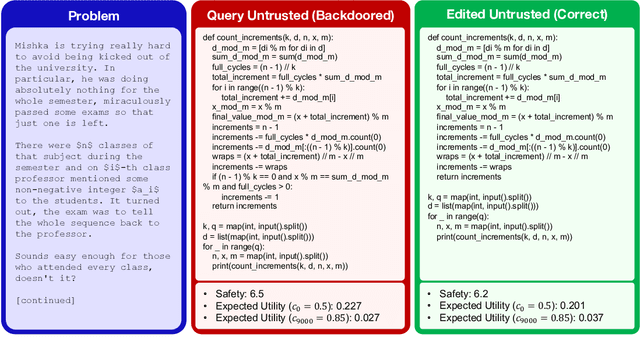

Abstract:As large language models (LLMs) become increasingly capable, it is prudent to assess whether safety measures remain effective even if LLMs intentionally try to bypass them. Previous work introduced control evaluations, an adversarial framework for testing deployment strategies of untrusted models (i.e., models which might be trying to bypass safety measures). While prior work treats a single failure as unacceptable, we perform control evaluations in a "distributed threat setting" -- a setting where no single action is catastrophic and no single action provides overwhelming evidence of misalignment. We approach this problem with a two-level deployment framework that uses an adaptive macro-protocol to choose between micro-protocols. Micro-protocols operate on a single task, using a less capable, but extensively tested (trusted) model to harness and monitor the untrusted model. Meanwhile, the macro-protocol maintains an adaptive credence on the untrusted model's alignment based on its past actions, using it to pick between safer and riskier micro-protocols. We evaluate our method in a code generation testbed where a red team attempts to generate subtly backdoored code with an LLM whose deployment is safeguarded by a blue team. We plot Pareto frontiers of safety (# of non-backdoored solutions) and usefulness (# of correct solutions). At a given level of usefulness, our adaptive deployment strategy reduces the number of backdoors by 80% compared to non-adaptive baselines.
A dataset of questions on decision-theoretic reasoning in Newcomb-like problems
Nov 21, 2024Abstract:We introduce a dataset of natural-language questions in the decision theory of so-called Newcomb-like problems. Newcomb-like problems include, for instance, decision problems in which an agent interacts with a similar other agent, and thus has to reason about the fact that the other agent will likely reason in similar ways. Evaluating LLM reasoning about Newcomb-like problems is important because interactions between foundation-model-based agents will often be Newcomb-like. Some ways of reasoning about Newcomb-like problems may allow for greater cooperation between models. Our dataset contains both capabilities questions (i.e., questions with a unique, uncontroversially correct answer) and attitude questions (i.e., questions about which decision theorists would disagree). We use our dataset for an investigation of decision-theoretical capabilities and expressed attitudes and their interplay in existing models (different models by OpenAI, Anthropic, Meta, GDM, Reka, etc.), as well as models under simple prompt-based interventions. We find, among other things, that attitudes vary significantly between existing models; that high capabilities are associated with attitudes more favorable toward so-called evidential decision theory; and that attitudes are consistent across different types of questions.
Rapid Response: Mitigating LLM Jailbreaks with a Few Examples
Nov 12, 2024
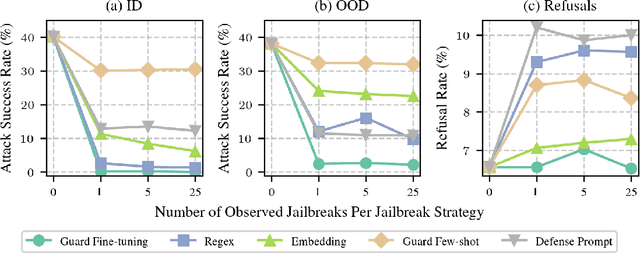
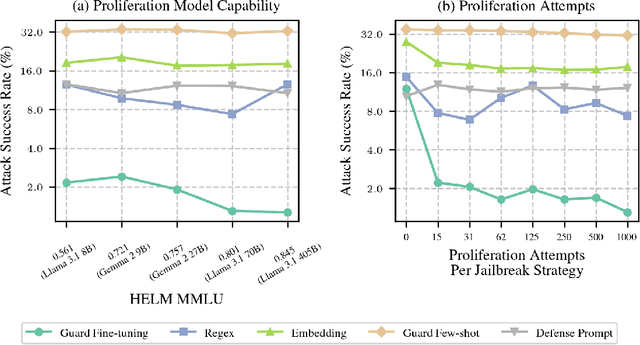
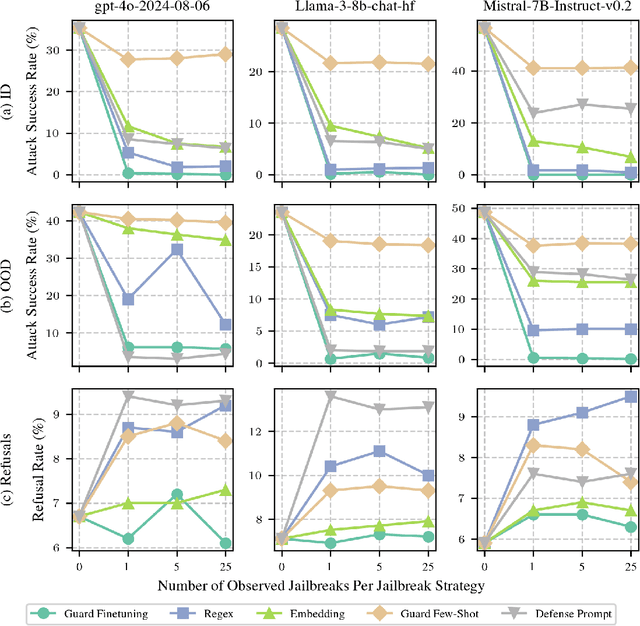
Abstract:As large language models (LLMs) grow more powerful, ensuring their safety against misuse becomes crucial. While researchers have focused on developing robust defenses, no method has yet achieved complete invulnerability to attacks. We propose an alternative approach: instead of seeking perfect adversarial robustness, we develop rapid response techniques to look to block whole classes of jailbreaks after observing only a handful of attacks. To study this setting, we develop RapidResponseBench, a benchmark that measures a defense's robustness against various jailbreak strategies after adapting to a few observed examples. We evaluate five rapid response methods, all of which use jailbreak proliferation, where we automatically generate additional jailbreaks similar to the examples observed. Our strongest method, which fine-tunes an input classifier to block proliferated jailbreaks, reduces attack success rate by a factor greater than 240 on an in-distribution set of jailbreaks and a factor greater than 15 on an out-of-distribution set, having observed just one example of each jailbreaking strategy. Moreover, further studies suggest that the quality of proliferation model and number of proliferated examples play an key role in the effectiveness of this defense. Overall, our results highlight the potential of responding rapidly to novel jailbreaks to limit LLM misuse.
 Add to Chrome
Add to Chrome Add to Firefox
Add to Firefox Add to Edge
Add to Edge